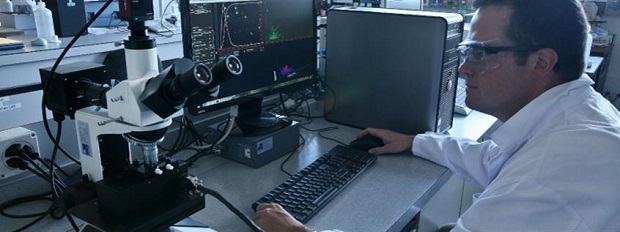OMYA (Canada) Inc.
Interdisciplinary Research

The result of providing a thriving center for technological endeavor is that we can focus on key areas for Omya's development through our R&D groups in surface science, mineral pigment and chemical engineering, as well as the world of microbiology and life sciences. For example, we have identified cluster programs for fundamental knowledge growth leading to a hands-on application of new concepts in nanotechnology, biomaterials and composites, surface science, new surface treatments and novel functionality, sustainable resourcing and smart process chemicals. Additionally, leader projects have been established for the support of innovation designed to keep Omya as the leader in its existing markets. Our teams include scientists from all disciplines, bringing their perspectives as chemists, physicist, mineralogists, geologists, mathematicians, material scientists and engineers into the topics.
Among other areas, linking calcium carbonate to the sustainable world of biomaterials has led us to explore the opportunities in processing nano-fibrillated cellulose, in removing heavy metals from contaminated waste waters around the world, in improving the efficiency of municipal water purification and in enhancing the controlled release of pharmaceutical drugs.
These are exciting challenges and we are ready to tackle them!

Minerals & Surfaces
All interactions between solids and their surroundings take place at so-called interfaces. What happens here defines all of the important aspects of life, from the smallest cell membrane right up to the biospheric interface between life on our planet and the rest of the universe.
It goes without saying that the Minerals & Surfaces research group is primarily interested in the behavior of calcium carbonate and other mineral particles in varied applications. Traditionally, the focus here was on plastics, coatings, paints and paper – industries in which huge quantities of calcium carbonate were and continue to be used as fillers or pigments. Nowadays, there are many new applications that place particular demands on our products and have led to many new developments in the field. One of the most important of these is the development of highly porous functional calcium carbonates, which have opened up a whole range of new applications.
Our inventory of equipment allows us to follow all of the steps in the working process, from raw stone right up to the finest ground products. This also includes their comprehensive colloidal characterization. Alternatively, we also have reactors of all sizes for carrying out precipitation or recrystallization. Our PCC (precipitated calcium carbonate) research mainly takes place in Gummern, Austria.
Our developments are created in close contact with the application-specific teams and departments at Omya – and ultimately with our customers from all over the world.

Pigment Chemical Engineering
The mission of the pigment chemical engineering research group is the design of pigments through physical and chemical methods in order to develop new products with improved properties and new functionalities. The group researches all aspects of wet and dry pigment engineering, covering the vast area of existing and new additives from dispersants and dry grinding agents to chemical stabilizers and surface treatments.
The available equipment allows us to study all aspects of wet and dry grinding, classification and surface treatment and functionalization. A synthesis lab also allows us to prepare specific molecules and polymers for research and pilot trials. The design of sustainable process chemicals based on renewable raw materials is a key guiding principle in all development work.

Microbiology
Life is everywhere, also in white mineral slurries. This is why Omya started to develop a competitive Microbiology research group. The work carried out brought new levels of understanding and identification of the microfauna in particulate mineral suspensions and the development of strategies to keep the "bugs" under control. Meanwhile, the competence achieved enabled a whole framework of Omyasmart solutions, which support a regulatory future with reduced levels of problematic biocides far beyond that of our original slurry products.
Omya Microbiology is the specialist division of Omya International AG. In addition to research and development and in-house services for Omya, we also offer our know-how and services to external customers.

Research Network
From the pioneering technical support within Omya during the mid to late 20th century, the visionary establishment of fundamental research and development activities toward the end of the 1990s has made Omya into a world-class research center in its field – right into the first decade of the 21st century and beyond. This has been achieved by a combination of academic networking, fundamental internal studies and the publication of ground-breaking research in peer-reviewed, high-ranking scientific journals, plus the far-sighted decision to develop and educate selected high flyers identified both within Omya's technical workforce and at institutional centers of excellence around the world.
The link to doctoral study programs at leading universities has served to strengthen the breadth and depth of knowledge underpinning the support of Omya's traditional markets and plays a key role in identifying emerging market opportunities based on a sound technical foundation.
Together with the technical service and innovation groups, Omya R&D forms the point of reference as solution provider, ranging from sample analysis to generating material properties, from microscopic imaging and beyond to new processing concepts, and applications as far removed from tradition as functionality in delivery vectors (for example, for flavorings, agronomics (plant care) and pharmaceuticals) to nanomaterials science.
Lists of cooperation partners, institutes and universities are illustrated in wide-ranging publications.
- Åbo Akademi, Finland (Turku)
- SP,Technical Research Institute of Sweden
- KTH University, Stockholm Sweden
- Innventia, Stockholm Sweden
- University of Plymouth, UK
- Université Strasbourg, France
- Technische Universität München (TUM)
- University of Basel, Switzerland
- University of North West Switzerland (Applied Sciences)
- Université du Québec, Trois Rivières, Canada
- University of Maine, Orono, US
- Universidad de la Republica, Institute Polo Tecnológico de Pando, Uruguay
- University of St. Petersburg, Russia
Source: https://www.omya.com/pages/US/en/interdisciplinary-research.aspx

|
Warehouse Specialist
Responsible for warehouse activities to ensure efficient utilization of facilities for storing and distributing material goods.